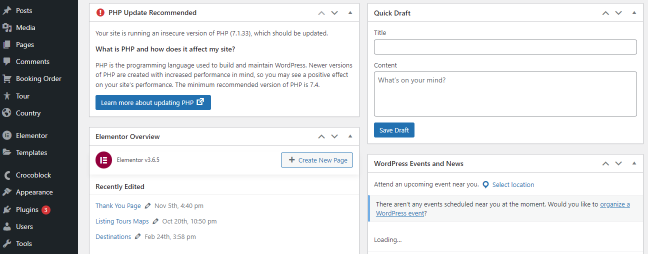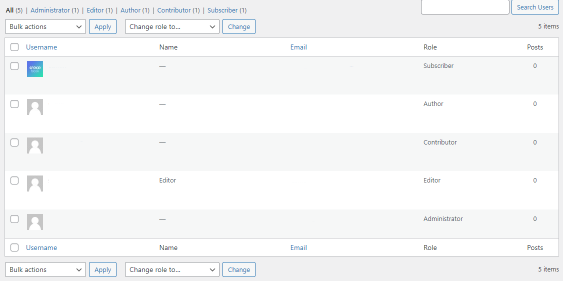Do you want to hire a handful of people today to assistance you work on a WordPress website but are frightened they will split every little thing? Or probably you would like no one other than the administrator to entry some site sections?
A one of a kind software from WordPress – consumer roles will help in each individual case.
Person roles permit you to give WordPress permissions to certain people to perform some tasks and block the means to provide other people. For case in point, a single individual can put in plugins on the internet site, edit web pages, etcetera., although an additional can only remark on posts.
What are these roles and which can be provided to the crew will be analyzed in this material.
Table of Contents
What Are Consumer Roles?

Person roles are attainable actions that a person or one more individual can complete. There are six of them in complete:
- Subscriber
- Contributor
- Creator
- Editor
- Administrator
- Tremendous administrator
These are people today who have a profile on your site and carry out some motion. Set up the Membership plugin and prolong the characteristics if you need a lot more roles and capabilities that these end users can conduct. The WordPress roles we will assess further more are conventional and accessible with no any plugins.
WordPress User Roles

Subscriber
It is a insignificant function. A individual with these WordPress permission has almost no chance to do anything on the web site. They can only see revealed posts, browse comments, and edit their profile. That’s all.
This attribute is effortless if you want the buyers to sign-up. For case in point, if you have an on the web retail outlet and want to make limited features to normal shoppers. Or, you want to make distinctive details readily available only to people who paid out for it.
In this circumstance, the consumer can sign up on the web site and get obtain to one thing one of a kind.
If you want a individual to execute a lot more functions, pick out a diverse part.
Contributor
This function has a lot more solutions but even now small performance. For example, a person with this job can make posts and view comments but are not able to approve and publish them.
Also, the participant can’t add photographs to their posts but can make new tags. Comparable to the subscriber position, this a person sees all the materials revealed on the web page and edits its publications.
This function is suited for those customers who often make content material for the site, e.g., guest posts. It safeguards from accidentally deleting currently published posts and offers people people today the capability to article new written content.
Creator
The writer is an extended version of the contributor. A human being with this position can edit, publish, delete their posts and see other folks. They can also assign classes to entries, deciding on from existing ones.
Like the contributor, these people can generate new tags and assign current tags to posts.
A particular person with this WordPress permission are unable to modify internet site settings, increase/clear away plugins, or moderate comments.
It is one of the most well-known and commonly utilised roles you can opt for in WordPress. Due to the fact it carries small challenges for the web-site proprietor, at the identical time, individuals with this amount of access can enable to generate content material on the web-site.
Editor
The WordPress purpose editor has additional possibilities than the writer. If you give this part to a person, they grow to be an absolute learn of the content on the site. They can insert, edit and delete web pages and posts on the web page, even if other folks made them. Furthermore, these types of a man or woman has total access to feedback – they can look at, approve, and delete them.
But a human being with this purpose nonetheless are unable to make alterations to the web page configurations, install plugins, or incorporate new customers to the website.
Editors can control the work of all authors who publish and submit on the resource.
Administrator
The administrator is the consumer with excellent electricity. By default, this job belongs to you. As a rule, there is only one web-site administrator. The directors have comprehensive accessibility to all WordPress capabilities. They can:
- add, edit and delete any components on the website
- see, approve, and delete feedback
- incorporate and edit site sections and tags
- change code
- set up or get rid of plugins on the website
- add media information
- adjust web page options
- assign roles
- edit the person profiles and transform their passwords
- incorporate and remove web-site members.
It would be ideal not to give these kinds of chances to some unfamiliar person since you award them complete electric power above the site.
Super admin
This purpose is not obtainable on any sources apart from for WordPress multisites. A human being with these a purpose is liable for all webpages in this kind of a community. In addition, they can add, edit, and delete internet sites and carry out common administrator capabilities.
The user’s toolbar with such obtain is identical to the admin panel.
If you have a network of WordPress sites and a super admin, some admin capabilities grow to be unavailable. The super administrator performs them. For example, they are authorized to put in and eliminate plugins or edit consumer data. The administrator can only determine irrespective of whether to allow mounted plugins or disable them.
How Do You Ascertain Which Roles to Give Consumers?
The primary rule to adhere to when you concern roles is to give the least necessary access. So, for example, if the person you are offering the part to is publishing content material, they do not need to have admin accessibility.
The stability of the internet site is dependent on this. Since if several individuals have prolonged entry, somebody may possibly accidentally clear away some plugin or alter the code simply by clicking “in the mistaken spot.”
Hence, the bigger the accessibility stage, the much less folks really should have it. For illustration, you can assign the Administrator part to the assistant, who moderates responses and checks the material, offering the place of editor. These who continually create written content need the Author job. For site visitors, subscriber access is adequate.
Then the web-site will be below management and in get.
If you see that some position lacks 1-2 unique features, you really should not give a larger accessibility level. To start with, check out extending the features with plugins.
How to assign roles we described in depth in this write-up. Go through and use.
FAQ
These are the characteristics you present to individual buyers. Each individual purpose corresponds to a distinct set of capabilities.
1st, you share permissions and responsibilities with the staff customers by assigning roles. Next, you make certain the safety of the web site. Simply because if you give out the username and password, you possibility losing the web page or some of the information.
It relies upon on the responsibilities it will execute, so if it is enough for them to see info on the site, the function of a subscriber will do. On the other hand, they need the editor purpose if you want them to edit written content and reasonable remarks.
Sure, you, as an administrator, can do this.
Conclusion
Roles on a WordPress web-site is a effortless and useful instrument that gives the means to acquire control of how the web page performs. It is valuable for individuals who frequently publish written content and improve information and facts on their web-site.
Now you know what roles WordPress delivers and how you can use them proficiently.